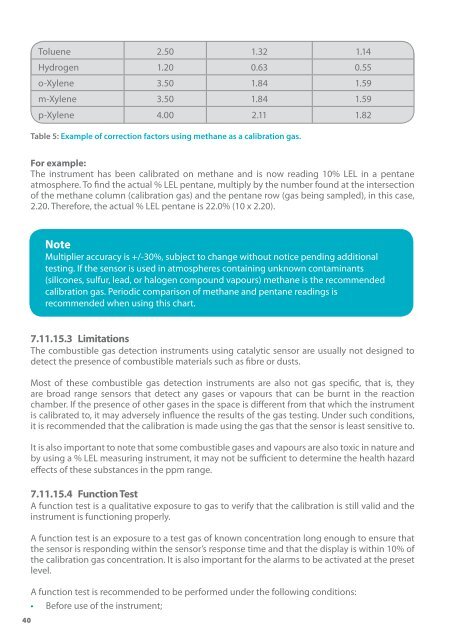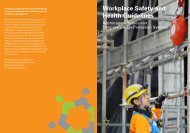Confined Spaces - Workplace Safety and Health Council
Confined Spaces - Workplace Safety and Health Council
Confined Spaces - Workplace Safety and Health Council
- No tags were found...
You also want an ePaper? Increase the reach of your titles
YUMPU automatically turns print PDFs into web optimized ePapers that Google loves.
Propene 1.80 0.95 0.821,2-Propyleneoxide 2.10 1.11 0.95Toluene 2.50 1.32 1.14Hydrogen 1.20 0.63 0.55o-Xylene 3.50 1.84 1.59m-Xylene 3.50 1.84 1.59p-Xylene 4.00 2.11 1.82Table 5: Example of correction factors using methane as a calibration gas.For example:The instrument has been calibrated on methane <strong>and</strong> is now reading 10% LEL in a pentaneatmosphere. To find the actual % LEL pentane, multiply by the number found at the intersectionof the methane column (calibration gas) <strong>and</strong> the pentane row (gas being sampled), in this case,2.20. Therefore, the actual % LEL pentane is 22.0% (10 x 2.20).Note: Note Multiplier accuracy is +/-30%, subject to change without notice pending additionaltesting.MultiplierIf the sensoraccuracyis usedis +/-30%,in atmospheressubject tocontainingchange withoutunknownnoticecontaminantspending additional(silicones,sulfur,testing.lead,Iforthehalogensensorcompoundis used in atmospheresvapors) methanecontainingis the recommendedunknown contaminantscalibration gas.Periodic(silicones,comparisonsulfur, lead,of methaneor halogen<strong>and</strong>compoundpentane readingsvapours)is recommendedmethane is thewhenrecommendedusing this chart.calibration gas. Periodic comparison of methane <strong>and</strong> pentane readings isrecommended when using this chart.• After an over-exposure to the targeted gas;• After exposure to extreme environmental conditions(Examples of extreme environmental conditions, +55°C in an engine room, positivelypressured atmosphere in an underground tunnel, water ingress when working outdoors, indrains, sewers, etc.);• After a severe physical jolt or was dropped;• When changing shift; or• When in doubt.This function test typically takes less than a minute to perform <strong>and</strong> it is not necessary to make acalibration adjustment unless readings are off from the expected value.7.11.15.5 Methods of Function TestingCalibration or function testing can be performed with the following accessories:• A known calibration gas that comes in compressed gas cylinders with traceable st<strong>and</strong>ardor analysis certificates which are available as a single or a mixture of gas. It is important thatexpired cylinders should not be used;• A regulator to reduce the cylinder pressure to a workable flow of gas; or• A flexible sample line <strong>and</strong> a calibration adapter which fits over the sensor inlet.Exhaust gasCalibration cradleSt<strong>and</strong>ard cylinder regulator7.11.15.3 LimitationsThe combustible gas detection instruments using catalytic sensor are usually not designed todetect the presence of combustible materials such as fibre or dusts.Most of these combustible gas detection instruments are also not gas specific, that is, theyare broad range sensors that detect any gases or vapours that can be burnt in the reactionchamber. If the presence of other gases in the space is different from that which the instrumentis calibrated to, it may adversely influence the results of the gas testing. Under such conditions,it is recommended that the calibration is made using the gas that the sensor is least sensitive to.O209OOOpen the cylinder by turningthe knob on the regulatorthat has a pre-adjusted flowof about 0.5 L/minIt is also important to note that some combustible gases <strong>and</strong> vapours are also toxic in nature <strong>and</strong>by using a % LEL measuring instrument, it may not be sufficient to determine the health hazardeffects of these substances in the ppm range.7.11.15.4 Function TestA function test is a qualitative exposure to gas to verify that the calibration is still valid <strong>and</strong> theinstrument is functioning properly.A function test is an exposure to a test gas of known concentration long enough to ensure thatthe sensor is responding within the sensor’s response time <strong>and</strong> that the display is within 10% ofthe calibration gas concentration. It is also important for the alarms to be activated at the presetlevel.Figure 13: Example of “function test” system.If the instrument does not perform properly after the function test, it is advisable that thecalibration is performed by trained personnel or is sent to manufacturer.Sequence of function test:• Attach the calibration adapter to the gas detection instrument;• Connect the hose <strong>and</strong> the calibration gas to the calibration adapter;• Switch on the gas detection instrument (for instrument that comes with function testmode, please follow the procedure given by the manufacturer);A function test is recommended to be performed under the following conditions:• Supply the calibration gas by turning the regulator valve manually;• Before use of the instrument;• Check the display on the gas detection instrument;40 41
















